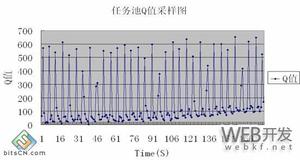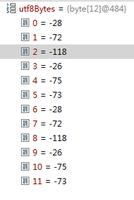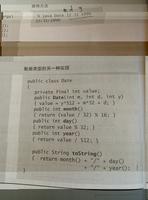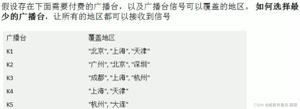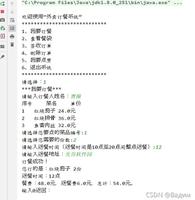java第六次作业 计科1501班 张鹏

java 第六次作业
计科1501 张鹏
1.用思维导图对本周的学习内容进行总结。
2.当程序中出现异常时,JVM会依据方法调用顺序依次查找有关的错误处理程序。可使用printStackTrace和getMessage方法了解异常发生的情况。阅读下面的程序,说明printStackTrace方法和getMessage方法的输出结果分别是什么?并分析异常的传播过程。
public class PrintExceptionStack { public static void main( String args[] )
{
try {
method1();
} catch ( Exception e ) {
System.err.println( e.getMessage() + "\n" );
e.printStackTrace();
}
}
public static void method1() throws Exception
{
method2();
}
public static void method2() throws Exception
{
method3();
}
public static void method3() throws Exception
{
throw new Exception( "Exception thrown in method3" );
}
}
printStackTrace方法的输出结果:
java.lang.Exception: Exception thrown in method3getMessage方法的输出结果是:
at test.Test.method3(Test.java:22) at test.Test.method2(Test.java:18)
at test.Test.method1(Test.java:14)
at test.Test.main(Test.java:6)
异常的传播:
在发生异常的地方直接处理,使用try{}catch(){}块,捕获到所发生的异常,并进行相应的处理。
3.阅读下面程序,分析程序的运行结果,解释产生错误的原因,如果删除的是books集合的最后一个对象,运行的结果又是什么?你能对此作出解释吗?如果在遍历时非要删除集合中的元素,应如何实现?
import java.util.*; public class Test
{
public static void main(String[] args)
{
Collection<String> books = new ArrayList<String>();
books.add("One book");
books.add("Two book");
books.add("Three book");
System.out.println("原始元素之后:"+books);
Iterator<String> it = books.iterator();
while(it.hasNext())
{
String book = (String)it.next();
System.out.println(book);
if (book.equals("One book"))
{
books.remove(book);
}
}
System.out.println("移除元素之后:"+books);
}
}
程序运行中会产生错误,因为在迭代时,如果调用集合对象的remove()方法删除对象,会出现运行错误,如果想要删除,必须调用迭代器本身的remove
()方法。
删除的是books集合的最后一个对象,运行的结果是
原始元素之后:[One book, Two book, Three book]One book
Exception in thread "main" Two book
Three book
java.util.ConcurrentModificationException
at java.util.ArrayList$Itr.checkForComodification(ArrayList.java:819)
at java.util.ArrayList$Itr.next(ArrayList.java:791)
at test.main(test.java:15)
假如删除的是最后一个对象的话,遍历输出时迭代器的大小其实没有发生改变,所以列表中的内容能够正常输出;当对最后一个对象进行删除时,迭代器的储存能力的大小发生变化,产生异常。
如果在遍历时非要删除集合中的元素,那么应该调用迭代器的remove()方法
程序如下:
Iterator<String> it = books.iterator();while(it.hasNext())
{
String book = (String)it.next();
System.out.println(book);
if (book.equals("One book"))
{
it.remove(book);
}
}
HashSet存储的元素是不可重复的。运行下面的程序,分析为什么存入了相同的学生信息?如果要去掉重复元素,应该如何修改程序。
import java.util.*; class Student {
String id;
String name;
public Student(String id, String name) {
this.id = id;
this.name = name;
}
public String toString() {
return "Student id=" + id + ", name=" + name ;
}
}
public class Test
{
public static void main(String[] args)
{
HashSet<Student> set = new HashSet<Student>();
set.add(new Student("1","Jack"));
set.add(new Student("2","Rose"));
set.add(new Student("2","Rose"));
System.out.println(set);
}
}
Set接口不允许存放重复元素。HashSet依靠Object类的hashCode()方法和equals()方法完成重复元素的判断。
hashCode():先判断对象的哈希码是否相同,依靠哈希码取出对象的内容。
equals():将对象的属性依次比较
所以,加入HashSet中的元素所属类必须重写hashCode()方法和equals()方法以确保对象的唯一性。
程序修改后如下(即重写hashCode()方法和equals()方法):
import java.util.*; class Student {
String id;
String name;
public Student(String id, String name) {
this.id = id;
this.name = name;
}
@Override
public int hashCode() {
final int prime = 31;
int result = 1;
result = prime * result + ((id == null) ? 0 : id.hashCode());
result = prime * result + ((name == null) ? 0 : name.hashCode());
return result;
}
@Override
public boolean equals(Object obj) {
if (this == obj)
return true;
if (obj == null)
return false;
if (getClass() != obj.getClass())
return false;
Student other = (Student) obj;
if (id == null) {
if (other.id != null)
return false;
} else if (!id.equals(other.id))
return false;
if (name == null) {
if (other.name != null)
return false;
} else if (!name.equals(other.name))
return false;
return true;
}
public String toString() {
return "Student id=" + id + ", name=" + name ;
}
}
public class test
{
public static void main(String[] args)
{
HashSet<Student> set = new HashSet<Student>();
set.add(new Student("1","Jack"));
set.add(new Student("2","Rose"));
set.add(new Student("2","Rose"));
System.out.println(set);
}
}
(二)实验总结
1.模拟KTV点歌系统
分别用LinkedList和ArrayList集合,实现一个模拟KTV点歌系统的程序。实现以下功能:
(1)显示歌曲列表
(2)添加歌曲到列表
(3)删除歌曲
(4)将歌曲置顶
(5)将歌曲前移一位
(6)退出
程序设计思路:分别建立LinkedList和ArrayList集合,然后分别调用两者所包含的方法,实现模拟KTV点歌系统的程序即可。
2.模拟微博用户注册
用HashSet实现一个模拟微博用户注册的程序。用户输入用户名、密码、确认密码、生日(格式yyyy-mm-dd)、手机号码(11位,13、15、17、18开头)、邮箱信息进行微博的注册。要求对用户输入的信息进行验证,输入信息正确后,验证是否重复注册,如果不是则注册成功,否则注册失败。
提示:
(1)设计一个用户类存储用户注册信息
(2)设计一个校验信息类,定义校验方法完成对输入信息的校验。学习使用正则表达式完成对生日、手机号码和邮箱的验证。
(3)设计一个用户注册类模拟注册过程。用HashSet存储用户数据列表,定义一个initData()方法添加初始用户信息。在main方法
程序设计思路:按照题目要求分别建立三个类,里边存上相应的方法供测试类进行调用。在Jiaoyan类里边定义jiaoyan()方法,依此判断输入的电话号码,生日类型以及邮箱是否与正规的匹配;在Userzhuce类里边建立zhuce()方法,以此来判断是否重复注册。
(三)代码托管
以上是 java第六次作业 计科1501班 张鹏 的全部内容, 来源链接: utcz.com/z/392398.html

